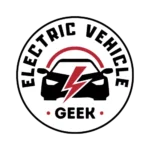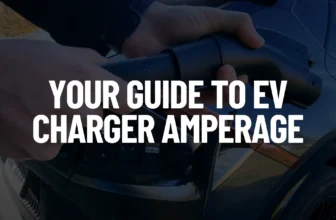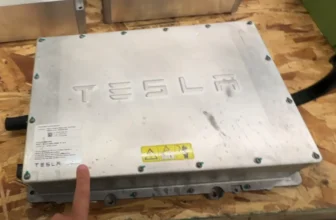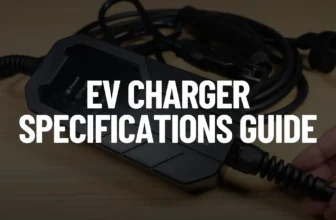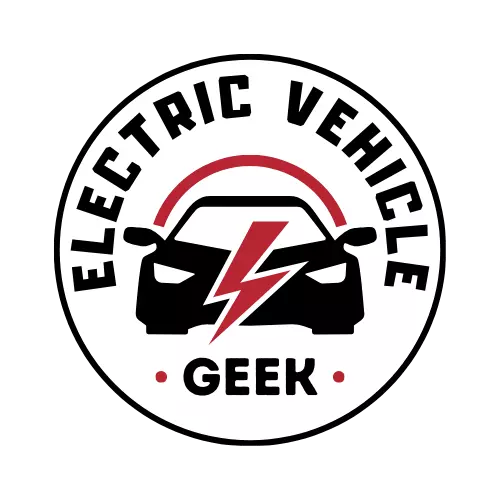Four types of hybrid electric vehicles are classified based on their engine, electric motor, electric power, and fuel savings. They include micro hybrid, mild hybrid, full hybrid, and plug-in hybrid electric vehicles.
In our previous guide on hybrid electric vehicles, we compared all-electric vehicles with hybrid cars, examining their advantages and disadvantages in terms of energy efficiency, energy storage options, and environmental impact.
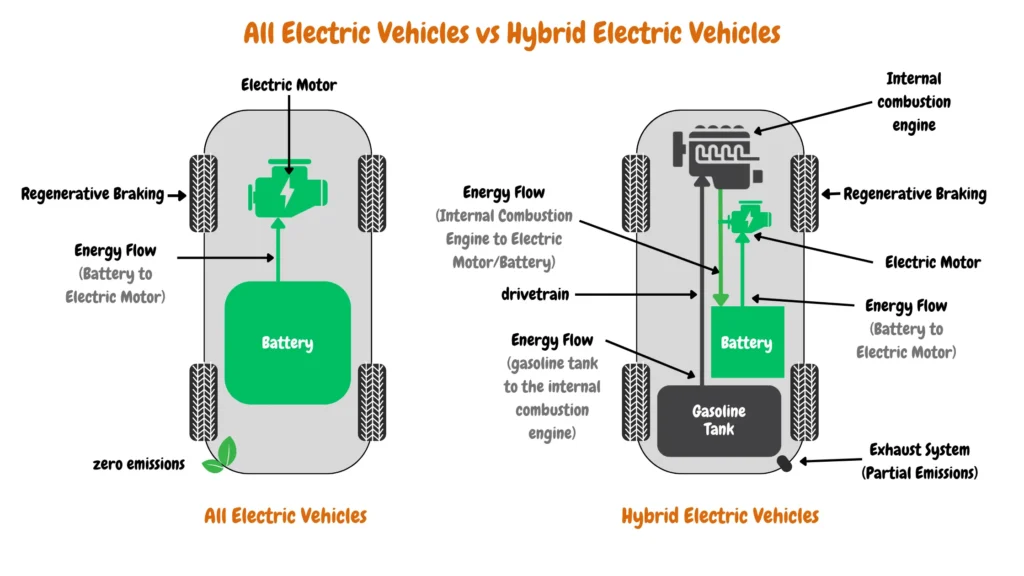
We found that potential electric vehicle owners considering a transition may find hybrid electric vehicles appealing, as they closely resemble the internal combustion engine vehicles they are familiar with. Hybrid cars utilize two power sources: the primary power source is typically an internal combustion engine, while the auxiliary power source is usually a battery. This dual system provides a smoother transition to electric mobility.
This guide is an extension to our original all-electric vehicles vs hybrid vehicles, so if you haven’t read that guide, we would recommend reading that guide first. Here >>
Table of Contents
Types of Hybrid Electric Vehicles (HEVs)
There are four primary types of hybrid electric vehicles (HEVs): micro hybrid, mild hybrid, full hybrid, and plug-in hybrid. Each type is designed with optimized engine configurations, electric motors, power capacities, operating voltages, and energy efficiencies tailored to its specific hybrid characteristics.
HEVs leverage the benefits of dual power sources, with the internal combustion engine serving as the primary source and a battery as the secondary source. This configuration allows for enhanced efficiency and performance compared to traditional internal combustion engine vehicles.
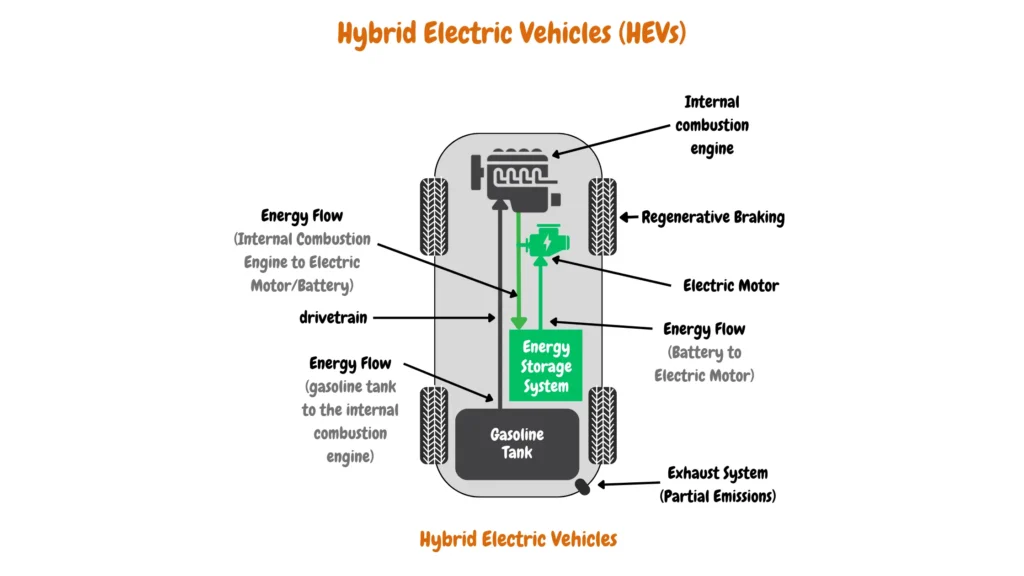
The drivetrain of a hybrid electric vehicle is engineered for superior efficiency, enabling seamless power distribution between the primary and secondary sources. This allows the engine to operate more effectively during acceleration and recharging, while also permitting the battery to assist the engine when needed.
In hybrid electric vehicles, power is drawn from both sources to facilitate acceleration and propulsion, especially in challenging terrains. The regenerative braking system captures energy during braking, redirecting it back to the battery for future use. This process significantly enhances overall fuel efficiency.
When considering the purchase of a hybrid electric vehicle, it is crucial to understand the distinctions between the four types and how their unique functionalities impact engine operations, regenerative braking, and various levels of propulsion. This knowledge will empower you to make an informed decision that aligns with your driving needs and environmental goals.
Micro Hybrid Electric Vehicles (Micro HEVs)
A micro hybrid electric vehicle, such as the Toyota Prius C, has better operations during start-up because it features a starter generator coupled to a conventional engine. The electric motor (Belt Drive/Crankshaft) of the hybrid electric vehicle helps the internal combustion engine optimize its operations during start-up.
The electric motor is used as a starter-alternator and combines automatic internal combustion engine start and stop operation with regenerative braking.
The electric power of micro-hybrid electric motors has capacities of 2-5kW and features a conventional 12V battery to reduce the fuel consumption of micro-hybrid vehicles. It’s important to note that the electric motor doesn’t provide torque to the engine when the vehicle is moving.
Compared to conventional engine vehicles, micro-HEVs have a fuel efficiency of up to 10% in urban driving. Micro-HEVs are common light-duty vehicles meant for urban driving, and we recommend micro-HEVs to users in urban environments where they provide maximum fuel efficiency on traffic stops and short-distance commutes.
Mild Hybrid Electric Vehicles (Mild HEVs)
Mild HEVs such as the Jeep Wrangler 4xe have a large electric motor compared to Micro HEVs; the electric motor also has a higher electric power between 6-12kW, and operates at a voltage of between 60 and 200V, which assists the internal combustion engine. Mild hybrid electric vehicles provide electrically assisted launch from a stop and charge recuperation during regenerative braking.
Mild HEVs don’t use the electric motor to power the engine; instead, the electric motor assists the internal combustion engine during acceleration and braking by providing supplementary torque since they share the same shaft.
This configuration helps mild-HEVs achieve fuel efficiency of up to 30% in urban driving. Due to the power of the electric motor, mild-HEVs can have a reduced internal combustion engine. Some popular mild-HEVs are the Honda Civic and Honda Accord.
Full Hybrid Electric Vehicles (Full HEVs)
Full HEVs, such as the Toyota Prius, are also known as power assist hybrids; their electric motor is powerful enough to be used as the sole source of power, and they feature a fully electric traction system and provide power directly to the engine during idling, launch, torque assistance, and regenerative braking.
One distinctive feature of full HEVs is that they can split power to the ICE, the electric motor, or both. We recommend full HEVs for people transitioning from conventional internal combustion engines who would like to achieve zero emissions, as a full HEV features a fully electric mode with zero emissions, and can switch back to a conventional internal combustion engine when needed.
Full HEVs feature an electric power of between 15-100kW with an operating voltage of 200V+. With this configuration, a full HEV can achieve up to 40% energy efficiency in urban driving without loss in driving performance.
Compared to Micro HEVs and mild HEVs, Full HEVs are quite expensive since they feature large batteries, electric motors, and improved battery components such as battery management systems (BMS) and cooling systems.
Plug-in Hybrid Electric Vehicles (Plug-in HEVs)
Plug-in HEVs, such as the 2025 Alfa Romeo Tonale or the 2025 Ford Escape SUV, are similar to Full HEVs; however, they feature an energy source system that can be charged by plugging into an electrical grid using a home EV charger.
They can be used as a BEV or an ICE, or as a BEV with extended driving range by having the ICE act as a generator that charges the plug-in HEV energy source system, usually a battery.
Plug-in HEVs feature a small battery compared to all-electric vehicles but a much bigger battery compared to Micro HEVs, Mild HEVs, and Full HEVs, allowing Plug-in HEVs to operate efficiently in electric mode.
Plug-in HEVs can be charged by using Level 1 EV chargers or Level 2 EV chargers that are lightweight, compact, and highly efficient smart Level 2 EV chargers in order to maximize the charging of the plug-in HEV battery from the grid.
Plug-in HEVs provide better driving performance in both urban, highway, and off-road conditions, have high energy efficiency, have a lower environmental impact, and lower operation costs than conventional internal combustion engines that rely on fossil fuels alone, depending on the driving behaviors and energy mix of the power generation.
Plug-in HEVs feature an electrical power of 70kW, and an operating voltage of 200V+, this configuration enables the Plug-in HEVs to have a fuel efficiency of more than 20% depending on the vehicle, drive-train, and driving conditions.

James Ndungu is a certified EV charger installer with over five years of experience in EVSE selection, permitting, and installation. He holds advanced credentials, including certification from the Electric Vehicle Infrastructure Training Program (EVITP) and specialized training in EV charging equipment and installation, as well as diplomas in EV Technology and Engineering Fundamentals of EVs. Since 2021, James has tested dozens of EV chargers and accessories, sharing expert insights into the latest EV charging technologies.
